Rem Koolhaas
Remment Lucas Koolhaas (Dutch pronunciation: [rɛm koːlɦaːs]; born 17 November 1944) is a Dutch architect, architectural theorist, urbanist and Professor in Practice of Architecture and Urban Design at the Graduate School of Design at Harvard University. He is often cited as a representative of Deconstructivism and is the author of ‘Delirious New York: A Retroactive Manifesto for Manhattan’.[1]
Rem Koolhaas | |
|---|---|
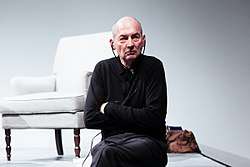 Rem Koolhaas in 2013 | |
| Born | Remment Lucas Koolhaas 17 November 1944 |
| Nationality | Dutch |
| Alma mater | Architectural Association School of Architecture, Cornell University |
| Occupation | Architect Architectural theorist Urbanist |
| Awards | Pritzker Prize (2000) Praemium Imperiale (2003) Royal Gold Medal (2004) Leone d'oro alla carriera (2010) |
| Practice | Office for Metropolitan Architecture |
| Buildings | Casa da Música in Porto De Rotterdam Seattle Central Library Netherlands Embassy Berlin China Central Television Headquarters Qatar National Library, 2017 |
| Projects | Volume Magazine |
He is seen by some as one of the truly significant architectural thinkers and urbanists of his generation, by others as a self-important iconoclast[2].[3][4][5] In 2000, Rem Koolhaas won the Pritzker Prize.[6] In 2008, Time put him in their top 100 of The World's Most Influential People.[7]
Early life and career
Remment Koolhaas, usually abbreviated to Rem Koolhaas, was born on 17 November 1944 in Rotterdam, Netherlands, to Anton Koolhaas (1912–1992) and Selinde Pietertje Roosenburg (born 1920). His father was a novelist, critic, and screenwriter. Two documentary films by Bert Haanstra for which his father wrote the scenarios were nominated for an Academy Award for Documentary Feature, one won a Golden Bear for Short Film. His maternal grandfather, Dirk Roosenburg (1887–1962), was a modernist architect who worked for Hendrik Petrus Berlage, before opening his own practice. Rem Koolhaas has a brother, Thomas, and a sister, Annabel. His paternal cousin was the architect and urban planner Teun Koolhaas (1940–2007). The family lived consecutively in Rotterdam (until 1946), Amsterdam (1946–1952), Jakarta (1952–1955), and Amsterdam (from 1955).[8][9][10]
His father strongly supported the Indonesian cause for autonomy from the colonial Dutch in his writing. When the war of independence was won, he was invited over to run a cultural programme for three years and the family moved to Jakarta in 1952. "It was a very important age for me," Koolhaas recalls "and I really lived as an Asian."[11]
In 1969, Koolhaas co-wrote The White Slave, a Dutch film noir, and later wrote an unproduced script for American soft-porn king Russ Meyer.[12]

He was a journalist in 1963 at age 19 for the Haagse Post[13] before starting studies in architecture in 1968 at the Architectural Association School of Architecture in London, followed, in 1972, by further studies with Oswald Mathias Ungers at Cornell University in Ithaca, New York, followed by studies at the Institute for Architecture and Urban Studies in New York City.
Koolhaas first came to public and critical attention with OMA (The Office for Metropolitan Architecture), the office he founded in 1975 together with architects Elia Zenghelis, Zoe Zenghelis and (Koolhaas's wife) Madelon Vriesendorp in London. They were later joined by one of Koolhaas's students, Zaha Hadid – who would soon go on to achieve success in her own right. An early work which would mark their difference from the then dominant postmodern classicism of the late 1970s, was their contribution to the Venice Biennale of 1980, curated by Italian architect Paolo Portoghesi, titled "Presence of the Past". Each architect had to design a stage-like "frontage" to a Potemkin-type internal street; the façades by Costantino Dardi, Frank Gehry and OMA were the only ones that did not employ Post-Modern architecture motifs or historical references.
Other early critically received (yet unbuilt) projects included the Parc de la Villette, Paris (1982) and the residence for the Prime Minister of Ireland (1979), as well as the Kunsthal in Rotterdam (1992). These schemes would attempt to put into practice many of the findings Koolhaas made in his book Delirious New York (1978),[14] which was written while he was a visiting scholar at the Institute for Architecture and Urban Studies in New York, directed by Peter Eisenman.[15]
Architectural theory
Delirious New York
Koolhaas's book Delirious New York set the pace for his career. Koolhaas analyzes the "chance-like" nature of city life: "The City is an addictive machine from which there is no escape" "Rem Koolhaas...defined the city as a collection of “red hot spots.”[16] (Anna Klingmann). As Koolhaas himself has acknowledged, this approach had already been evident in the Japanese Metabolist Movement in the 1960s and early 1970s.
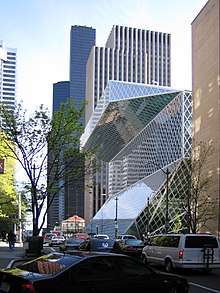
A key aspect of architecture that Koolhaas interrogates is the "Program": with the rise of modernism in the 20th century the "Program" became the key theme of architectural design. The notion of the Program involves "an act to edit function and human activities" as the pretext of architectural design: epitomised in the maxim form follows function, first popularised by architect Louis Sullivan at the beginning of the 20th century. The notion was first questioned in Delirious New York, in his analysis of high-rise architecture in Manhattan. An early design method derived from such thinking was "cross-programming", introducing unexpected functions in room programmes, such as running tracks in skyscrapers. More recently, Koolhaas unsuccessfully proposed the inclusion of hospital units for the homeless into the Seattle Public Library project (2003).[17]
S,M,L,XL
The next controversial publication by Koolhaas was S,M,L,XL, together with Bruce Mau, Jennifer Sigler, and Hans Werlemann (1995),[18] a 1376-page tome combining essays, manifestos, diaries, fiction, travelogues, and meditations on the contemporary city. The layout of the massive, chaotic book influenced architectural publishing, some would say for the worse, and such books—full-colour graphics and dense texts—have since become common. Ostensibly, S,M,L,XL gives a record of the actual implementation of "Manhattanism" throughout the various (mostly unrealized) projects and texts OMA had generated up to that time. The part lexicon-type layout (with a marginal "dictionary" composed by Jennifer Sigler, who also edited the book) spawned a number of concepts in architectural theory, in particular "Bigness": the contention that 'old' architectural principles (composition, scale, proportion, detail) no longer apply when a building acquires Bigness. The book argues that this was demonstrated in OMA's scheme for the development of "Euralille" (1990–94), a new centre for the city of Lille in France, a city returned to prominence by its position on the new rail route from Paris to London via the Channel Tunnel. OMA sited a train station, two centres for commerce and trade, an urban park, and 'Congrexpo' (Lille Grand Palais, a contemporary "Grand Palais" with a large concert hall, three auditoria and an exhibition space) with Cecil Balmond.
Project on the city
Koolhaas's next publications were a byproduct of his position as professor at Harvard University, in the Design school's "Project on the City"; firstly the 720-page Mutations,[19] followed by The Harvard Design School Guide to Shopping (2002)[20] and The Great Leap Forward (2002).[21]
All three books published student work analysing what others would regard as "non-cities", sprawling conglomerates such as Lagos in Nigeria, west Africa, which the authors argue are highly functional despite a lack of infrastructure. The authors also examine the influence of shopping habits and the recent rapid growth of cities in China. Critics of the books have criticised Koolhaas for being cynical – as if Western capitalism and globalization demolish all cultural identity – highlighted in the notion expounded in the books that "In the end, there will be little else for us to do but shop". Perhaps such caustic cynicism can be read as a "realism" about the transformation of cultural life, where airports and even museums (due to finance problems) rely just as much on operating gift shops. It does, however, demonstrate one of the architect's characteristic devices for deflecting criticism: attack the client or subject of study after completing the work.
When it comes to transforming these observations into practice, Koolhaas mobilizes what he regards as the omnipotent forces of urbanism into unique design forms and connections organised along the lines of present-day society. Koolhaas continuously incorporates his observations of the contemporary city within his design activities: calling such a condition the ‘culture of congestion’. Again, shopping is examined for "intellectual comfort", whilst the unregulated taste and densification of Chinese cities is analysed according to "performance", a criterion involving variables with debatable credibility: density, newness, shape, size, money etc.
In 2003, Content, a 544-page magazine-style book designed by &&& Creative and published by Koolhaas, gives an overview of the last decade of OMA projects[22] including his designs for the Prada shops,[6] the Seattle Public Library, a plan to save Cambridge from Harvard by rechanneling the Charles River, Lagos' future as Earth's third-biggest city, as well as interviews with Martha Stewart and Robert Venturi and Denise Scott Brown.
Volume Magazine
In 2005, Rem Koolhaas co-founded Volume Magazine together with Mark Wigley and Ole Bouman. Volume Magazine – the collaborative project by Archis (Amsterdam), AMO Rotterdam and C-lab (Columbia University NY) – is a dynamic experimental think tank devoted to the process of spatial and cultural reflexivity. It goes beyond architecture’s definition of ‘making buildings’ and reaches out for global views on architecture and design, broader attitudes to social structures, and creating environments to live in. The magazine stands for a journalism which detects and anticipates, is proactive and even pre-emptive – a journalism which uncovers potentialities, rather than covering done deals.
Buildings and projects
In the late nineties, while working on the design for the new headquarters for Universal[23] (currently Vivendi), OMA was first exposed to the full pace of change that engulfed the world of media and with it the increasing importance of the virtual domain. It led Rem Koolhaas and the Office for Metropolitan Architecture (OMA) to establish a new company, AMO, exclusively dedicated to research, headed by Reinier de Graaf.
Indeed, online marketing and propaganda has been a hallmark of OMA's rise in the current century. It has also led to pointed criticism, such as the critique by New York Magazine critic Justin Davidson, who found the 2020 Guggenheim exhibition Countryside, the Future "mildly amusing if it weren’t such terrible waste — of attention, of gallery square footage, of resources, talent, and expertise. Bored with being an architect and building things, Koolhaas lets his fingertips graze important topics, genuine insights, and actual lives. He treats them all as ironic bric-a-brac, meaningless souvenirs of his meanderings through a fragile world. How frustrating that the Guggenheim couldn’t force a little more intellectual rigor on this romp."[24] Research projects, generally accompanied by exhibitions, have also included curating the Venice Biennale several times and producing a "critical" exhibition about the pseudo-history behind historic preservation.
European Flag proposal
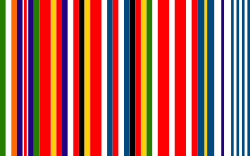
Following the signing of Treaties of Nice in May 2001, which made Brussels the de facto capital of the European Union, the then President of the European Commission, Romano Prodi and the Belgian Prime Minister Guy Verhofstadt invited Koolhaas to discuss the necessities and requirements of a European capital.
During these talks and as an impetus for further discussion, Koolhaas and his think-tank AMO suggested the development of a visual language. This idea inspired a series of drawings and drafts, including the "Barcode". The barcode seeks to unite the flags of the EU member countries into a single, colourful symbol. In the current European flag, there is a fixed number of stars. In the barcode however, new Member States of the EU can be added without space constraints. Originally, the barcode displayed 15 EU countries. In 2004, the symbol was adapted to include the ten new Member States.
Since the time of the first drafts of the barcode it has very rarely been officially used by commercial or political institutions. During the Austrian EU Presidency 2006, it was officially used for the first time. The logo was used for the EU information campaign, but was very negatively criticized. In addition to the initial uproar caused by the Estonian flag stripes being displayed incorrectly, the proposed flag failed to achieve its main objective as a symbol. Critics pointed the lack of capability to relate the signified (the mental concept, the European Union) with the signifier (the physical image, the stripes) as the major problem, as well as the presented justification for the order in which the color stripes were displayed (as every country in the EU should be regarded as equal in importance and priority).
Architecture, fashion, and theatre

With his Prada projects, Koolhaas ventured into providing architecture for the fleeting world of fashion and with celebrity-studded cachet: not unlike Garnier's Opera, the central space of Koolhaas' Beverly Hills Prada store is occupied by a massive central staircase, ostensibly displaying select wares, but mainly the shoppers themselves. The notion of selling a brand rather than marketing clothes was further emphasised in the Prada store on Broadway in Manhattan, New York,[6] which had previously been owned by the Guggenheim: the museum signs were not removed during the outfitting of the new store, as if emphasizing the premises as a cultural institution.[25] The Broadway Prada store opened in December 2001, cost €32 million to build, and has 2,300 square meters of retail space.[6]
Prior to his Prada project in New York, Koolhaas was behind another remodeling project on the other side of town. Koolhaas redesigned a 1929 bank and transformed it into a one-of-a-kind, 296 seat, performance space for Second Stage Theatre in Manhattan.
21st Century Projects
Probably the most costly and celebrated OMA projects of the new century were the massive Central China Television Headquarters Building in Beijing, China, and the new building for the Shenzhen Stock Exchange, the equivalent of the NASDAQ in China. In his design for the new CCTV headquarters in Beijing (2009), Koolhaas did not opt for the stereotypical skyscraper, often used to symbolise and landmark such government enterprises; he patented a "horizontal skyscraper" in the U.S. The building, popularly called "The Big Pants" by Beijing residents, was designed as a series of volumes which attempt to tie together the numerous departments onto the nebulous site, but also introduce routes (again, the concept of cross-programming) for the general public through the site, allowing them some degree of access to the production procedure. An unfortunate incident that highlighted the folly of the circulation scheme (no effective fire egress for people on the upper floors), was the construction fire that nearly destroyed the building and a nearby hotel in 2009.[26]
Recently, he has changed the organization of his office to a partnership. Partners next to him are Ellen van Loon, Reinier de Graaf, Shohei Shigematsu, Jason Long, Iyad Alsaka, Victor van der Chijs and managing partner David Gianotten. The partner Ole Scheeren left OMA in March 2010 to start his own practice.Koolhaas now heads offices in Europe (OMA*AMO Rotterdam), North America (OMA*AMO Architecture PC New York) and Asia (OMA Beijing).
The head office in Rotterdam did a master plan for the White City area of London; a harbour redevelopment and contemporary art Museum in Riga, the Cordoba Congress Centre in Spain; the redevelopment of the Mercati Generali in Rome, an architectural centre, offices and housing in Copenhagen, the new head office of Rothschild Bank in London and multi-use towers in Rotterdam and The Hague. It is also working on various masterplans in the Netherlands and Belgium and shopping centres in Rotterdam and Ostrava. In addition the Rotterdam office has a number of activities in the Middle East including office and residential towers and master plans in Dubai, three master plans in Ras al-Khaimah and several public buildings in Qatar. With his Rotterdam office Koolhaas is also designing a science center for Hamburg’s HafenCity.
At the office in Manhattan Koolhaas is leading by Shohei Shigematsu is now designing an extension of Cornell University (NY), 111 First Street, a high rise residential building and hotel in Jersey City (NJ) and a high end residential tower with CAA screening room at One Madison Park in NYC.
OMA has left its imprint on many architecture students and architects who have worked at the office during their careers. Architects such as Bjarke Ingels (BIG), Jeanne Gang (Studio Gang), Amale Andraos and her husband Dan Wood (WORKac) are just some of the names of the many architects that have worked in the office.
Personal life
Koolhaas was previously married to Madelon Vriesendorp, an artist who is the mother of his two children, Charlie, a photographer, and Tomas, a filmmaker.[27] Koolhaas divorced Vriesendorp in 2012.[28] He has known his current partner Petra Blaisse, an interior and landscape designer since 1986.[27][28]
Honours and awards
- Honorary Fellow of the American Institute of Architects (Hon. FAIA) (USA, 1999)
- Pritzker Prize (USA, 2000)
- Knight of the Légion d'honneur (France, 2001)
- Praemium Imperiale (Japan, 2003)
- Royal Gold Medal (UK, 2004)
- Doctor honoris causa (Dr.h.c.) from the Katholieke Universiteit Leuven (Belgium, 2007)
- Golden Lion of the Venice Biennale of Architecture for lifetime achievement (Italy, 2010)
- Commander of the Ordre des Arts et des Lettres (France, 2018)[29]
Selected projects
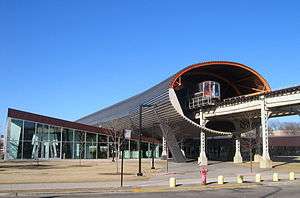
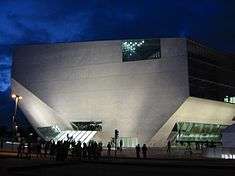
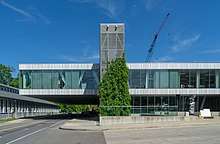
- Parc des expositions de Toulouse, (Toulouse)
- Euralille, Lille Grand Palais (with Cecil Balmond) and Zénith de Lille masterplan (Lille, 1994)
- Netherlands Dance Theater with Madelon Vriesendorp (The Hague, 1988)
- Villa dall’Ava,[30] (Saint-Cloud, 1991)
- Nexus Housing (Fukuoka, 1991)
- Kunsthal (Rotterdam, 1993)
- Educatorium (Utrecht, 1993–1997)
- Maison à Bordeaux[31] (Bordeaux, 1998)
- Second Stage Theatre (Manhattan, New York City, 1999)
- Guggenheim Hermitage Museum (Las Vegas, 1980, 2002?)
- McCormick Tribune Campus Center, IIT (Chicago, 1997–2003)
- Netherlands Embassy Berlin (2003)
- Retail design for Prada stores (New York: 2003, Los Angeles: 2004)
- Seattle Central Library (Seattle, 2004)
- The Children’s Centre, Leeum, Samsung Museum of Art (Seoul, 2004)[32]
- Casa da Música (Porto, 2001–2005)
- Serpentine Gallery Pavilion, with Cecil Balmond, (London, 2006)
- Shenzhen Stock Exchange, (Shenzhen, 2006)
- Córdoba International Congress Center (Centro de Congresos de Córdoba) – Palacio del Sur, Córdoba, Spain
- Seoul National University Museum of Art (Seoul, 2003–2005) [33]
- Dee and Charles Wyly Theatre, (Dallas, Texas, 2004–2009)
- Milstein Hall, College of Architecture, Art, and Planning at Cornell University (Ithaca, NY, 2011)[34][35]
- CCTV HQ (Beijing, 2004–2009)
- Riga Port City, (Riga, 2009)
- 23 East 22nd Street, (New York City, 2008–2010)[36]
- Bryghusprojektet, Danish Architecture Centre, (Copenhagen, 2008–?)[37]
- Torre Bicentenario (Bicentennial Tower), (Mexico City, 2007, unbuilt)[38]
- New Court, St. Swithin's Lane (London, 2010)
- De Rotterdam, (Rotterdam, 2009–2013)
- Garage Museum of Contemporary Art, (Moscow, 2012-2014)
- Taipei Performing Arts Centre, (Taipei, 2012–)
- Marina Abramović Community Centre Obod Cetinje – MACCOC, (Cetinje, 2012 – ?)[39]
- The Factory, (Manchester 2019)[40]
- 122 East 23rd Street, first completed project in New York City
- Galleria Department Store, Gwanggyo Store, (Suwon, 2017–2020)[41]
Bibliography
Primary source
- Project Japan. Metabolism Talks... (2011) (with Hans Ulrich Obrist)[42] ISBN 978-3-8365-2508-4
- Delirious New York: A Retroactive Manifesto for Manhattan (1978)[43] ISBN 978-1-885254-00-9
- S,M,L,XL (1995)[44] ISBN 978-1-885254-86-3
- Serpentine Gallery: 24 Hour Interview Marathon (2007)[45] ISBN 978-1-904563-69-3
- Living Vivre Leben (1998)[46]
- Content (2004)[47] ISBN 978-3-8228-3070-3
- Serpentine Gallery Pavilion 2006; Verlag der Buchhandlung Walther König, Köln, Germany 2008 ISBN 978-3-86560-393-7
Secondary source
- Böck, Ingrid: Six Canonical Projects by Rem Koolhaas: Essays on the History of Ideas. (Berlin: Jovis Verlag, 2015) ISBN 978-3-86859-219-1
- Dunham-Jones, Ellen, "The Irrational Exuberance of Rem Koolhaas," Places Journal, April 2013, accessed June 15, 2020, https://doi.org/10.22269/130402
- Enwezor, Okwui; Patteeuw, Véronique (ed.): What is OMA?: Considering Rem Koolhaas and the Office for Metropolitan Architecture. (Rotterdam: NAi Publishers, 2003)
- Filler, Martin: Makers of Modern Architecture, Volume II: From Le Corbusier to Rem Koolhaas [New York Review Collections]. (New York: New York Review Books, 2013)
- Gargiani, Roberto: Rem Koolhaas / OMA. (Roma-Bari: Laterza, 2006) ISBN 9788842079286
- Gargiani, Roberto: Rem Koolhaas / OMA: The Construction of Merveilles (Essays in Architecture). Translated from the Italian by Stephen Piccolo. (New York: Routledge, 2008) ISBN 9780415461450
- Lefas, Pavlos: Dwelling and Architecture: From Heidegger to Koolhaas. (Berlin: Jovis Verlag, 2009) ISBN 978-3-86859-012-8
- Van Gerrewey, Christophe (ed.): OMA/Rem Koolhaas: A Critical Reader from "Delirious New York" to "S,M,L,XL". (Basel: Birkhäuser Verlag, 2019) ISBN 978-3-0356-1977-5
- Yaneva, Albena: Made by the Office for Metropolitan Architecture: An Ethnography of Design. (Rotterdam: NAi Publishers, 2009)
- Yaneva, Albena: The Making of a Building: A Pragmatist Approach to Architecture. (New York: Peter Lang, 2009)
Filmography
- Bêka, Ila; Lemoine, Louise: Koolhaas Houselife (documentary film, 2008, 58min)
- Heidingsfelder, Markus; Tesch, Min (directors): Rem Koolhaas: A Kind of Architect. (Production: Arthouse Films, New York, Duration: 98 minutes, Language: Dutch, English (English subtitles), 2008)
- Koolhaas, Tomas: Rem (documentary film, 2016, 75 min)
Gallery
References
- Caves, R. W. (2004). Encyclopedia of the City. Routledge. pp. 411. ISBN 9780415252256.
- Michael Kimmelman, "Why Rem Koolhaas Brought a Tractor to the Guggenheim," New York Times, Feb. 20, 2020, accessed online.
- Ouroussoff, Nicolai (September 2012). "Why is Rem Koolhaas the World's Most Controversial Architect?". Smithsonian Magazine. Retrieved 28 June 2016.
Koolhaas’ habit of shaking up established conventions has made him one of the most influential architects of his generation. A disproportionate number of the profession’s rising stars, including Winy Maas of the Dutch firm MVRDV and Bjarke Ingels of the Copenhagen-based BIG, did stints in his office. Architects dig through his books looking for ideas; students all over the world emulate him. The attraction lies, in part, in his ability to keep us off balance. Unlike other architects of his stature, such as Frank Gehry or Zaha Hadid, who have continued to refine their singular aesthetic visions over long careers, Koolhaas works like a conceptual artist—able to draw on a seemingly endless reservoir of ideas.
- Quirk, Vanessa (17 November 2012). "Rem Koolhaas: A Reluctant Architect". ArchDaily.com. Retrieved 28 June 2016.
- Kunkel, Patrick (28 July 2015). "Ingrid Böck's "Six Canonical Projects by Rem Koolhaas" Dissects the Ideas that have Made Koolhaas' Career". ArchDaily.com. Retrieved 28 June 2016.
- Chevalier, Michel (2012). Luxury Brand Management. Singapore: John Wiley & Sons. ISBN 978-1-118-17176-9.
- Lacayo, Richard (30 April 2009). "Rem Koolhaas". Time Retrieved on 12 May 2008. Retrieved 22 May 2010.
- Moor, Wam de (13 March 2008). "Koolhaas, Anthonie (1912–1992)". Biografisch Woordenboek van Nederland (in Dutch). Instituut voor Nederlandse Geschiedenis. Retrieved 14 May 2008.
- "Anthonie Koolhaas". De Boekenweek (in Dutch). Archived from the original on 1 December 2008. Retrieved 14 May 2008.
- Anker, Eva van den. "Dirk Roosenburg". Archipedia (in Dutch). Architectenweb. Retrieved 14 May 2008.
- Adams, Tim (25 June 2006). "Metropolis Now". The Observer, Guardian Unlimited. London.
- Becker, Lynn (10 October 2007). "Oedipus Rem". Repeat: Writings on Architecture.
- Lootsma, Bart (4 September 2007). "Koolhaas,Constant and Dutch Culture in the 1960s" (PDF). Architecturaltheory.eu.
- Koolhaas, Rem (1978) Delirious New York: A retroactive Manifesto for Manhattan, Academy Editions, London; republished, The Monacelli Press, 1994, ISBN 1885254008
- Ciuffi, Valentina (9 June 2014). "Rem Koolhaas is stating 'the end' of his career, says Peter Eisenman". dezeen.com. Retrieved 7 August 2019.
- Klingmann, A (2007) Brandscapes: Architecture in the Experience Economy. Mit Press, ISBN 0262515032
- "Spotlight: Rem Koolhaas". ArchDaily. 17 November 2018.
- Koolhaas, Rem; Werlemann, Hans and Mau, Bruce (1994) S,M,L,XL, The Monacelli Press, New York, (2nd edition 1998) ISBN 1885254865
- Koolhaas, Rem et al. (2001) Mutations, Arc en rêve centre d’architecture, Bordeaux, ISBN 84-95273-51-9.
- Koolhaas, Rem; Chung, Chuihua Judy; Inaba, Jeffrey and Leong, Sze Tsung (2002) The Harvard Design School Guide to Shopping. Harvard Design School Project on the City 2, Taschen, New York, ISBN 3822860476
- Koolhaas, Rem et al. (2002) The Great Leap Forward. Harvard Design School Project on the City, Taschen, New York, ISBN 3822860484
- Koolhaas, Rem (2003) Content, Taschen, New York, ISBN 3822830704
- "Finding aid for the OMA Universal Studios project records". Canadian Centre for Architecture. Retrieved 9 April 2020.
- Justin Davidson, ""Farm Livin' Is the Life for Me, Ja? Rem Koolhaas tries out country life," New York Magazine, Feb. 24, 2020, accessed online.
- Anette Baldauf (2004) "Branded", in Learning from Calvin Klein, Umbau 21.
- David Flumenbaum, ""CCTV Headquarters Fire: Rem Koolhaas Building Survives Blaze," Huffington Post, March 12, 2009; updated Dec. 6, 2017.
- Lubow, Arthur (9 June 2014). "Rem Koolhaas Is Not a Starchitect". The W Magazine. Retrieved 13 October 2015.
- Lubow, Arthur. "Rem Koolhaas Is Not a Starchitect". W Magazine. Retrieved 20 December 2019.
Koolhaas and Blaisse have been together since 1986—not living together, she notes, “but having a life together.” Three years ago, they began sharing an apartment. Two years later, he obtained a divorce from Madelon Vriesendorp, an artist who is the mother of his two children.
- Genovesi, Iñaki Oñorbe (21 February 2018). "Architect Rem Koolhaas ontvangt hoogste Franse cultuuronderscheiding". de Volkskrant.
- VILLA DALL’AVA. WhatWeDoIsSecret.org (18 January 2007). Retrieved on 25 February 2015.
- Stories Of Houses. Storiesofhouses.blogspot.com (24 February 2004). Retrieved on 20 March 2014.
- Astudillo, Tey-Marie (27 October 2011) Seoul's best museums Archived 28 September 2012 at the Wayback Machine. Cnngo.com.Retrieved on 20 March 2014.
- snumoa.org. snumoa.org. Retrieved on 20 March 2014.
- milsteinhall.cornell.edu. milsteinhall.cornell.edu. Retrieved on 20 March 2014.
- "Milstein Hall: Built to Inspire". Cornell Architecture Art Planning. Cornell AAP. Retrieved 15 January 2019.
Since its opening in 2011
- 23 East 22nd Street by OMA. Dezeen.com (15 September 2008). Retrieved on 20 March 2014.
- Bryghusprojektet – The Brewery Site Project. Bryghusprojektet.dk. Retrieved on 20 March 2014.
- official site in Spanish
- "Marina Abramović Community Center Obod Cetinje new Montenegro's development reality". Government of Montegro. 10 January 2012. Retrieved 10 February 2015.
- Brown, Mark (25 November 2015). "Rem Koolhaas wins Factory design project as Manchester goes Dutch". The Guardian. Guardian Media Group. Retrieved 26 November 2015.
- Won, Ho-jung (6 April 2017). "Hanwha Galleria to open luxury outlet in Gwanggyo". The Korean Herald. The Korea Herald. Retrieved 28 January 2020.
- "Project Japan. Metabolism Talks..." Taschen. Retrieved 4 April 2012.
- "Delirious New York: A Retroactive Manifesto of Manhattan". Office for Metropolitan Architecture. Retrieved 18 May 2008.
- "SMLXL". Office for Metropolitan Architecture. Archived from the original on 10 June 2008. Retrieved 18 May 2008.
- "Serpentine Gallery: 24 Hour Interview Marathon". Trolley Books. Retrieved 18 May 2008.
- "Living Vivre Leben". Office for Metropolitan Architecture. Archived from the original on 10 June 2008. Retrieved 18 May 2008.
- "Content". Office for Metropolitan Architecture. Archived from the original on 9 April 2008. Retrieved 18 May 2008.
External links
| Library resources about Rem Koolhaas |
| By Rem Koolhaas |
|---|
| Wikiquote has quotations related to: Rem Koolhaas |
| Wikimedia Commons has media related to Rem Koolhaas. |
- Office for Metropolitan Architecture
- OMA official Facebook page (updated daily)
- OMA official Vimeo channel
- OMA portfolio on Archello.com
- Rem Koolhaas at Harvard University
- Rem Koolhaas on IMDb
- Urgency 2007: Rem Koolhaas and Peter Eisenman lectures, Canadian Centre for Architecture, June 8, 2007
- Rem Koolhaas in conversation with Mirko Zardini and Giovanna Borasi, Rotterdam, August 26, 2015, for the exhibition The Other Architect, Canadian Centre for Architecture
- On Starchitecture
- Koolhaas at Harvard's Ecological Urbanism
- Rem Koolhaas: A Kind of Architect (2008 Feature Documentary)
- Rem Koolhaas lecture "Russia for Beginners" at Garage Museum of Contemporary Art: September 15th, 2014
- Rem Koolhaas on Empty Canon


.jpg)